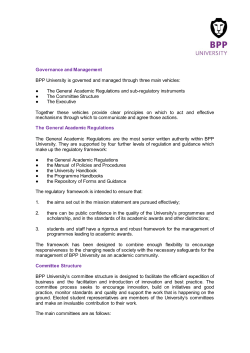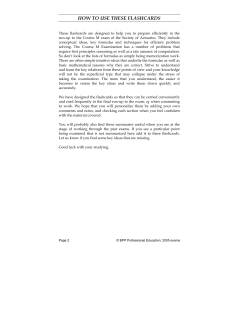
Online Tutor Resource for CIM assessments Sample slideset BPP LEARNING MEDIA
Online Tutor Resource for CIM assessments Sample slideset BPP LEARNING MEDIA Customers and needs Key term — A customer is ‘an individual or organisation who buys a product or service’ (Doole et al, 2005). These are individuals who have no connection with an organisation, other than that they may have purchased goods or services in the past, or are purchasing at present. — A consumer / user is ‘the person who uses the product and service or may be affected by its purchases’ (Doole et al, 2005). While the most obvious customer is the person who purchases the product or service, the consumer is the end-user – the person who actually uses the product or service and is sometimes different from the purchaser. BPP LEARNING MEDIA BPP Learning Media: Official Educational Publisher of CIM Customers and needs Types of individual customers — According to Doole et al (2005), not all customers will behave in a similar fashion. Customers can be differentiated by the way they purchase products and services into four different types: — (a) The economic / rational customer: This customer makes purchase decisions based on economic rationale alone. This customer has been able to access a complete understanding of all the other alternatives and has fully evaluated them to be able to identify the best one. — (b) The passive customer: This customer is basically submissive and makes irrational purchase decisions. Passive customers are usually impulsive and easily swayed by marketing promotions. — (c) The cognitive customer: This customer focuses on the purchasing process by seeking information and evaluating that information in the light of perceived risks in order to arrive at a decision. — (d) The emotional customer: This customer views making purchases to satisfy emotional needs as entirely rational and puts a lot of emphasis on the search for information. Current mood and feeling are the key determinants of the purchase decision and emotive benefits of the alternatives are much more important than rational attributes. BPP LEARNING MEDIA BPP Learning Media: Official Educational Publisher of CIM Customers and needs — The benefits of a marketing oriented approach — The main benefits of a marketing orientated approach are: — (a) By making customer needs a primary focus, companies are more likely to develop products and services that meet the needs of the customers. The likelihood of repeat purchases and brand loyalty is increased as customers experience a higher level of satisfaction. — (b) Marketing orientated companies have all functions properly aligned with the strategic vision of meeting the needs of customers. This helps define the role of employees more clearly. — (c) Firms that possess a good understanding of customer needs are in a position to market more effectively to them. — (d) Consistently understanding and delivering what customers wants leads to long-term profitability. Market-oriented companies can turn one-time buyers into repeat customers, with the ultimate goal of developing many loyal customers who are more willing to pay higher prices . BPP LEARNING MEDIA BPP Learning Media: Official Educational Publisher of CIM Collecting information about customer needs The importance of information — Putting the customer at the centre of the organisation’s activities and responding effectively to the changes in the external environment requires access to quality, pertinent and timely information to guide management decisions. According to Doole et al (2005), the specific functions of information include: — Information can be used to establish general trends in the environment — Information can be used to scan the environment for opportunities and threats — Information can enable the organisation to assess competitor activity — Information can help the organisation to explore and examine consumer behaviour and help the organisation to design its approach to the customer — Information can help the firm to gauge the extent to which its resources ‘fit’ with its ambitions. BPP LEARNING MEDIA BPP Learning Media: Official Educational Publisher of CIM Collecting information about customer needs The importance of information — Overall, marketers need information to help them to make decisions. These decisions should ultimately help the organisation to better meet the needs of customers by understanding — Differing customer needs and wants — Why customers purchase eg what makes them choose certain products over others — The factors that influence customer decision-making — This information can then be used to develop an appropriate and effective marketing mix of activities to meet those needs. BPP LEARNING MEDIA BPP Learning Media: Official Educational Publisher of CIM Collecting information about customer needs The importance of information — Here is a list of questions that marketers might need answered. — (a) Markets. Who are our customers? What are they like? How are buying decisions made? — (b) Share of the market. What are total sales of our product? How do our sales compare with competitors' sales? — (c) Products. What do customers think of our product? What do they do with it? Are our products in a 'growth' or 'decline' stage of their life cycle? Should we extend our range? — (d) Price. How do our prices compare with others: higher, average, lower? Is the market sensitive to price? — (e) Distribution. Should we distribute directly, indirectly or both? What discounts are required? BPP LEARNING MEDIA BPP Learning Media: Official Educational Publisher of CIM Collecting information about customer needs The importance of information — Continuation list of questions that marketers might need answered. — (f) Sales force. Do we have enough / too many salespeople? Are their territories equal to their potential? Are they contacting the right people? Should we pay commission? — (g) Advertising. Do we use the right media? Do we communicate the right message? Is it effective? — (h) Customer attitudes. What do they think of our product / firm / service / delivery? — (i) Competitors' activities. Who are our competitors? Are they more or less successful businesses? Why are they more or less successful? — (j) Environmental factors. What factors impact on marketing planning (PESTEL factors)? BPP LEARNING MEDIA BPP Learning Media: Official Educational Publisher of CIM Collecting information about customer needs Sources of information for marketers BPP LEARNING MEDIA BPP Learning Media: Official Educational Publisher of CIM Creating a customer database Key terms — Secondary data is information that has already been collected, originally for a specific purpose, but which is later used for a purpose other than that for which it was collected. Secondary data is data that already exists in some form. Collection of secondary data is known as 'desk research'. — Primary data is information collected for a specific purpose and derived from a new and original source. Primary data is information collected specifically to address a question posed by the marketer. It is used to bridge any identified gaps that might exist in a company’s knowledge. Primary data may be qualitative (figures and statistics) or quantitative (attitudes and feelings) in nature. Methods of collecting primary data Qualitative data collection methods Quantitative data collection methods In-depth interview Survey Focus groups Observation eg scanned bar code data Analysis of online discussion forums Online voting buttons BPP LEARNING MEDIA BPP Learning Media: Official Educational Publisher of CIM Creating a customer database The quality of data All data collected should be evaluated using the following criteria. (a) Is the data relevant to the purpose for which it was collected? (b) Is it up-to-date? (c) Is it reliable and accurate? (d) Is the source of the data credible and objective, or unbiased? Look for the following. BPP LEARNING MEDIA BPP Learning Media: Official Educational Publisher of CIM Creating a customer database — Sources of Information in a customer database BPP LEARNING MEDIA BPP Learning Media: Official Educational Publisher of CIM The value of customer information — Identifying the factors that influence decision-making — Customers do not operate within a vacuum merely deciding what they are going to go out and buy that day. They have a range of influences and constraints imposed upon them that will affect their buying decisions. — Some are external influences, economic conditions will determine how much disposable income they have. There have been various articles expressing concern on the level of consumer spending on credit but people generally consider what they can afford rather than just go out and buy. The increasing effect of technology on the home may mean a consumer is encouraged to upgrade the family PC to enable them to access better services. — The consumer also has internal influences that will affect their buying decision. Peer group pressure is a strong influence and organisations should recognise that word-of-mouth recommendations are a powerful communications tool. We need to gain an understanding of these to fully appreciate what our communications message has to achieve. BPP LEARNING MEDIA BPP Learning Media: Official Educational Publisher of CIM Customers and stakeholders — Stakeholders are individuals and/or groups who are affected by or affect the performance of the organisation in which they have an interest. Typically they would include employees, managers, creditors, suppliers, shareholders (if appropriate) and society at large.’ (Worthington & Britton, 2006) — There are three broad categories of stakeholder in an organisation. — (a) Internal stakeholders, who are members of the organisation. Key examples include the directors, managers and employees of a company – or the members of a club or association, or the volunteer workers in a charity. They may also include other functions of the organisation (eg marketing, production or finance) which have a stake in marketing activity, and/or separate units of the organisation (eg regional or product divisions) which have a stake in its plans. — (b) Connected stakeholders (or primary stakeholders), who have an economic or contractual relationship with the organisation. Key examples include the shareholders in a business; the customers of a business or beneficiaries of a charity; distributors and intermediaries; suppliers of goods and services; and financers / funders of the organisation. — (c) External stakeholders (or secondary stakeholders), who are not directly connected to the organisation, but who have an interest in its activities, or are impacted by them in some way. Examples include the government, pressure and interest groups (including professional bodies and trade unions), the news media, the local community and wider society. BPP LEARNING MEDIA BPP Learning Media: Official Educational Publisher of CIM Customers and stakeholders — Stakeholders in the marketing organisation BPP LEARNING MEDIA BPP Learning Media: Official Educational Publisher of CIM Marketing and customer relationships Ladder of loyalty BPP LEARNING MEDIA BPP Learning Media: Official Educational Publisher of CIM Marketing and customer loyalty — You have probably heard it said that ‘It’s ten times cheaper to keep a customer than it is to get a new one.’ Most people would agree with this statement, even though they have no way of proving it. Benefits of retaining customers are described below. — (a) Likelihood of repeat business: Products and services that satisfy customers will make them come back again, thus giving the firm repeat business. Repeat business reduces the firm’s cost of customer acquisition and also saves the customer the associated costs involved in switching suppliers. — (b) Facilitates greater interaction between the business and customer: As most markets move away from mass produced standard products and services to customised products and services, repeat business provides an opportunity for the firm to build a more focused relationship based on customer needs and requirements. — (c) Reduced cost of customer acquisition: Having a repeat customer enables the firm to save on most costs traditionally associated with customer acquisition; including advertising, sales presentations, follow-up and travel costs. It also creates the potential for the company to attract more customers through word-of-mouth advertising. BPP LEARNING MEDIA BPP Learning Media: Official Educational Publisher of CIM Supply chain marketing Key term The supply chain – the network of suppliers, manufacturers and distributors involved in the production and delivery of a product. (CIM) — A good working relationship with suppliers and other ‘partners’ can produce dramatic effects, such as: — Innovation — Improved performance — Lower costs — More holistic solutions to problems — Better understanding of the needs of all parties — New ways of working together — More co-operation BPP LEARNING MEDIA BPP Learning Media: Official Educational Publisher of CIM Building and developing relationships Internal co-operation — Just as individuals have internal customers, such as colleagues and line managers, that they have to deal with, organisations have internal customers in the form of their staff. — From an organisation’s perspective, internal communication is vital to internal marketing, and the maintenance of employee motivation and company competitiveness. Simple methods of communication can be used to keep staff informed about new products/services, internal restructuring or how well (or not) the organisation is doing. In dynamic environments, where firms need to manage change effectively, communication needs to be harnessed to help staff adapt and become familiar with changes in their working environment. BPP LEARNING MEDIA BPP Learning Media: Official Educational Publisher of CIM Internal relationships Internal co-operation According to Berry and Parasuraman (1991), who are widely credited with recognising the importance of internal marketing, ‘a service company can be only as good as its people: if they aren’t sold, customers won’t be either.’ The point here is that most organisations provide at least some level of customer service as part of their product offering and increasingly it is seen as a way of differentiating products in an overcrowded market. Without a culture of internal marketing and effective internal customer communications, the employees within an organisation face the following problems: — Communication problems — Frustration and non-co-operation — Time-wasting and inefficiency — Stress and lack of job satisfaction — Poor quality of work. BPP LEARNING MEDIA BPP Learning Media: Official Educational Publisher of CIM Sources of conflict — The causes of conflict ict BPP LEARNING MEDIA BPP Learning Media: Official Educational Publisher of CIM Overcoming conflict — Mullins (2010) identified some strategies for managing conflicts. (a) Clarification of goals and objectives. The clarification and continual refinement of goals and objectives, role definitions and performance standards will help to avoid misunderstandings and conflict. (b) Human resource management policies and procedures. Careful and detailed attention to just and equitable HRM policies and procedures may help to reduce areas of conflict. (c) Development of interpersonal/group process skills. This may help engender a better understanding of one’s own behaviour, the other person’s point of view, communication processes and problem-solving. (d) Group activities. Attention to the composition of groups and to factors that affect group cohesiveness may reduce dysfunctional conflict. (e) Leadership and management. A more participative and supportive style of leadership and managerial behaviour is likely to assist in conflict management. (f) Organisational processes. Conflict situations may be reduced by attention to such features as the nature of the authority structure; work organisation; patterns of communication and sharing of information. There are also a number of formal methods available to deal with internal conflict: BPP LEARNING MEDIA BPP Learning Media: Official Educational Publisher of CIM Co-operation and collaboration Total Quality Management (TQM) is a management approach for an organization, centred on quality, based on the participation of all its members and aiming at long-term success through customer satisfaction, and benefits to all members of the organisation and to society. (ISO) Contributing constructive ideas — A dialogue between marketing and non-marketing staff will allow the development of marketing plans and activities that are more likely to be successful. The use of brainstorming techniques might be of benefit here. — Brainstorming is a group creativity technique designed to generate a large number of ideas for the solution to a problem. Co-operating with others to follow plans — Once plans have been developed, they must be implemented. As we have already seen, marketing is a cross-functional activity, and the help and commitment of staff outside the marketing department will be needed if plans are to succeed. — The successful implementation of marketing plans might require the organisation to form one or more multidisciplinary project teams.to be led by, members of the marketing department. Keeping commitments — It is very important that, whatever promises are made regarding services to be performed or information to be supplied, these promises are met. Most organisations now take a ‘total quality’ approach to activity. BPP LEARNING MEDIA BPP Learning Media: Official Educational Publisher of CIM Customer databases and tactical marketing To communicate with customers effectively, we need to know who they are, what needs the products or services are required to meet, where they are located and the most cost-effective methods of communicating with them. Internal market — We all keep a database of internal customers, whether we intend to or not. Most e-mail systems (such as Microsoft’s Outlook) allow us to access address books or contact lists, and these can be used to build mailing lists for internal direct marketing. External market — Communicating with external customers and prospects is more important, and more complex, than with internal customers. We need to know who these individuals or organisations are, and much more. Connected stakeholders — There are big ethical and legal issues related to passing customer data to third parties. However, an organisation can extract certain data, or summarise it, and pass this anonymous data to other interested parties. BPP LEARNING MEDIA BPP Learning Media: Official Educational Publisher of CIM Customer care and customer service — Customer care is ‘a fundamental approach to the standards of service quality’ which ‘covers every aspect of a company’s operations from the design of a product or service to how it is packaged, delivered and serviced’ (Clutterbuck, 2001) Customer service systems BPP LEARNING MEDIA BPP Learning Media: Official Educational Publisher of CIM Customer care and relationship marketing — Customers want to feel valued by the employees they encounter. They want their questions answered in a confident and courteous way, not using jargon, and not assuming they have a high level of subject knowledge. — The five key areas where care systems exist are as follows: 1) Sales and ordering – consider the speed of processing orders. Is the customer updated regularly? 2) Accounts and invoicing – accuracy and a variety of payment methods are key here. Is affordable credit required? 3) Delivery – is delivery time specific, when the customer wants? Are the goods delivered intact? 4) After-sales – dealing with customer questions. How easy is it for customers to contact you? 5) Complaints – how easy is it to complain? Do complaints get resolved? Staff will be able to respond effectively to customers if they follow some simple guidelines. BPP LEARNING MEDIA BPP Learning Media: Official Educational Publisher of CIM Designing a customer care programme BPP LEARNING MEDIA BPP Learning Media: Official Educational Publisher of CIM Obtaining customer feedback Formal and informal methods of data collections Formal feedback collection Surveys, telephone, web based, questionnaire Informal feedback methods Front line staff-customer discussions Online forums (on organisation's website) Online forums and review sites set up by third parties Suggestion boxes Analysis of formal complaints data Review customer retention figures Sales figure analysis BPP LEARNING MEDIA BPP Learning Media: Official Educational Publisher of CIM Press monitoring Monitoring the success of customer service Why monitor success? — Continuous improvement, through the adoption of such initiatives as total quality management (TQM), business process re-engineering (BPR) and Kaizen (the Japanese philosophy of continuous improvement), has been one of the core themes of business management during the past decade. The goal of modern business is no longer just ‘to be good’ but ‘to be better than our competitors’. The analysis of complaints — Is it the case that a fall in the number of customer complaints means that our customer service levels are improving? Or are our customers no longer complaining to us (because they realise it does no good) and are now complaining to each other (or, even worse, to our competitors)? Sales records — The ‘bottom line’ of customer service is the level of revenues we earn. If sales are rising, we must be doing something right. Customer retention — It is very true that ‘a happy customer comes back for more’. Looking at the conversion rate from ‘new customer’ to ‘repeat purchase’ can give us an indication of how customers perceive our service levels, but no more than that. Existing customer data — If a happy customer comes back for more, then a very happy customer probably comes back more frequently, and for ever-greater quantities. BPP LEARNING MEDIA BPP Learning Media: Official Educational Publisher of CIM Monitoring the success of customer service Using Mystery Shoppers — The point-of-sale is the critical moment of truth in determining whether a customer is satisfied, the sale is made, or if a customer ever buys from you again. Evaluation of this interaction is important in understanding the type of service your customer is receiving and whether sales associates or team members are following your prescribed procedures and protocols. In essence, on-site mystery shoppers look at sales and service efforts from two perspectives – the customer’s as well as the company’s. — On-site mystery shoppers also have the advantage of being able to assess the physical aspects of the location including: the cleanliness and upkeep of the facility, the proper use of merchandising and marketing materials, the appearance of the staff and their attire (including uniforms), product presentation and demonstration, and so on. — Provided the identity of mystery shoppers is kept confidential, this is one of the best ways of getting direct feedback about service levels, from three perspectives: 1) At a point in time – how are we doing? 2) Over time – are we improving? 3) In comparison to our competitors – are we better than them? BPP LEARNING MEDIA BPP Learning Media: Official Educational Publisher of CIM Using IT in customer service activities — Data mining is when sophisticated systems are used to track customer or client files to identify products or services that could be targeted in the future. — Database marketing is an interactive approach to marketing which uses individually addressable marketing media and channels to extend help to a company's target audience, stimulate their demand and stay close to them by recording and keeping an electronic database memory of customer, prospect and all communication and commercial contacts, to help them improve all future contacts and ensure more realistic planning of all marketing. — Internet and database technologies offer some key advantages for gathering customer data. The key to their value is keeping the data up to date and relevant. — Market research into customers' 'stated intentions' and perceptions can be replaced or augmented by actual customer behaviour and demonstrated preferences: websites allow the tracking and storage of customer browsing (identifying areas of interest) and transaction/purchase history. BPP LEARNING MEDIA BPP Learning Media: Official Educational Publisher of CIM Using IT in customer service activities Market research and customer feedback gathering can be carried out via such methods as: — Online or e-mail-distributed questionnaires and feedback forms — 'Message boards' on the website, allowing visitors to communicate with the company (and each other) — Site monitoring to record hits, browsing and purchase patterns of users — Inviting e-mailed comments and suggestions — Such methods are more convenient for the customer than face-to-face interviews and writing/mailing: they require less effort and allow 24-7 flexibility. From the company's point of view, they also facilitate the immediate analysis and integration of results, automatic 'thank you' messages and so on. Companies can also access external online databases compiled and managed by specialist data providers: market research publishers (for example, Mintel and Keynote), producers of statistical data (for example, the UK Central Statistical Office and Eurostat) and others. BPP LEARNING MEDIA BPP Learning Media: Official Educational Publisher of CIM Managing yourself — SMART objectives Working through objectives Working through objectives BPP LEARNING MEDIA BPP Learning Media: Official Educational Publisher of CIM
© Copyright 2025











